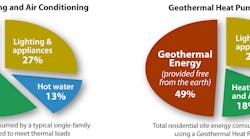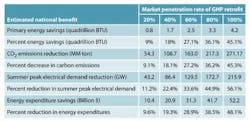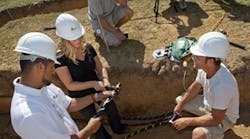Latest from Residential HVAC
The amount of energy in the Earth is mind-boggling. Geothermal heat pump technology taps into that energy and uses it to provide reliable, incredibly efficient heating and cooling in both residential and commercial buildings. Geothermal heating and cooling is a win-win-win. It’s a win for HVAC contractors because it allows you to provide your customers with state-of-the-art, environmentally friendly technology. It’s a win for their customers because it reduces their utility costs. And it’s a win for the environment.
Geothermal heat pumps are the most efficient way to heat and cool a building. The thermal load of a building can be satisfied very efficiently with a geothermal heat pump, and the technology continues to improve. And the industry is not resting on its laurels: new equipment coming into the marketplace is super-efficient, with energy efficiency ratios (EERs) exceeding 40, and coefficients of performance (COPs) greater than 5.
In addition, the geothermal industry is a job creator. Installation of a geothermal system requires skilled people equipped with both knowledge and drilling rigs. Add to that the service industry required for those drilling rigs, as well as pipe manufacturers and grout manufacturers, and there are thousands of jobs unique to our industry that are being created by this technology.
Challenges and Solutions
The geothermal heat pump industry is poised for growth and we encourage HVAC contractors to get involved with it. There are several challenges often perceived as obstacles to entry, but they are generally either misconceptions or can be easily overcome. They include:
• Consumers aren’t aware of geothermal.This challenge can be directly addressed by HVAC contractors. The contractor network for geothermal technology nationally basically creates the market — the larger the network, the larger the market. Any HVAC company that has geothermal heat pumps in its portfolio (and people who know how to express the benefits of geothermal technology) expands the market. Encouraging HVAC contractors to get involved in geothermal technology is a key to consumer awareness efforts.
•Geothermal systems have a high first cost. We at the Geothermal Exchange Organization were successful in getting an ongoing 30% federal income tax credit applied to geothermal technology, and we are working across the country on adopting public policies that will encourage electric utilities to offer financial incentives to home and building owners who opt for a geothermal heat pump.
The combination of the 30% federal income tax credit, financial incentives from the electric utility industry, and favorable tax code changes to depreciation, makes choosing geothermal almost a “no-brainer,” because those incentives remove much of the cost differential between geothermal and conventional HVAC technology.
• Geothermal requires highly trained personnel. The industry has made great strides in contractor training and certification to help ensure that systems are designed and installed correctly. We’re able to train contractors on the entire process — loop design and installation, and equipment design and installation — so the education and training concern is rapidly evaporating.
It’s true that geothermal systems require specially trained and certified designers and installers. A geothermal loop field heat exchange is not a chiller boiler, and designers and installers must know what they’re doing. We work continually with ASHRAE and the International Ground Source Heat Pump Association on training curriculums, and we work throughout the industry to ensure that training is widely available.
• Energy-saving technology isn’t valued by lenders.At the federal level, a bill (S. 1737 or the SAVE Act) has been introduced in the Senate that would require mortgage lending companies to include the energy-efficiency of a building in their loan analysis. That would be a huge boon for the geothermal industry.
In the meantime, we’re constantly in talks with builders about how much sense it makes to put a very efficient heating and cooling system into a home at basically no cost to the homeowner. If you take the cost differential between a geothermal system and a traditional system and have the homeowners put that into a 30-year mortgage, the energy savings are greater than the debt service on the added mortgage. Therefore, homeowners actually will experience a positive cash flow from their geothermal system every day they own the home.
The challenge is changing the mindset of how people view the technology and trying to overcome their reluctance because of the first cost. And we’re trying to convince lenders of the same thing. When a builder is working with a homeowner and putting in geothermal, the homeowner must be able to articulate to the mortgage lender, and the mortgage lender must appreciate, that having a geothermal heat pump in a home means the family living there will have more disposable income on a monthly basis. This increases the chances of the family making their mortgage payment.
For example, every Habitat for Humanity home that’s built in Oklahoma is equipped with a geothermal heat pump and a solar photovoltaic system. The average daily energy cost for these Habitat for Humanity homes is $1. So for somewhere less than $400 per year, that family can heat, cool, and provide hot water for their needs. The difference between that and the energy costs for a traditional HVAC air-source central air conditioning unit and a furnace can mean hundreds of dollars in a low-income person’s pocket on a monthly basis. That’s called breaking the cycle of poverty through energy efficiency.
Scalable, Practical, Poised to Expand
Geothermal heating and cooling technology is scalable: the utility savings are there both residentially and commercially. We can show benefit to a low-income person living in a Habitat for Humanity home, all the way up to the IKEA building that was built in Denver using geothermal heat pump technology. In both cases the numbers are indisputable about how efficient this equipment is.
It’s also practical. Many contractors think it’s difficult if not impossible to retrofit a home or building with a geothermal system, especially on a small city lot. However, 200-ft. vertical boreholes can be punched in one day, so if someone is having a driveway re-done, for example, it can be easy to put a geothermal system into place. Commercial buildings in downtown areas typically employ a water-to-water configuration. There are large commercial buildings in New York City that are being retrofitted on an open-loop access. If there’s a standing column well, very little space is required to access it. There are drilling rigs that can be assembled in the basement of a building to drill down far enough to put a loop in. So we can pretty much overcome any property restriction, thanks to today’s technology.
What is the key need for geothermal moving forward? All we really need is for the economy to come back strong. That, combined with the growing acceptance of this technology, will create a “snowball” effect, and geothermal’s marketshare will increase significantly over time. Our industry is tied at the hip to the economy of this country. If we want to make a big comeback, our economy has to make a big comeback. I think the economy is poised to expand and we’re right there with it.
Doug Dougherty is president and CEO of the Geothermal Exchange Organization. He can be reached at 217/414-0341 or by email at [email protected]. This article is based on a presentation Doug gave to HVAC contractors during 2012 HVAC Comfortech. Visit www.hvaccomfortech.com for information about the 2013 event, Sept. 18-20, in Philadelphia, PA.












